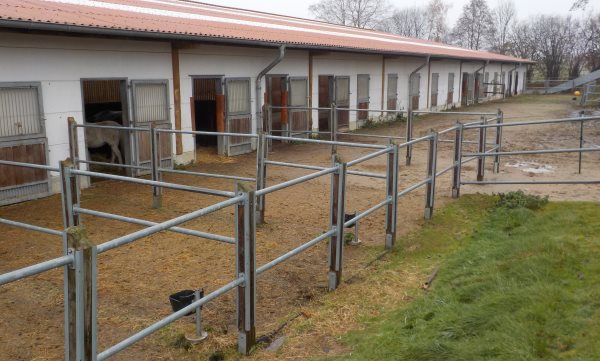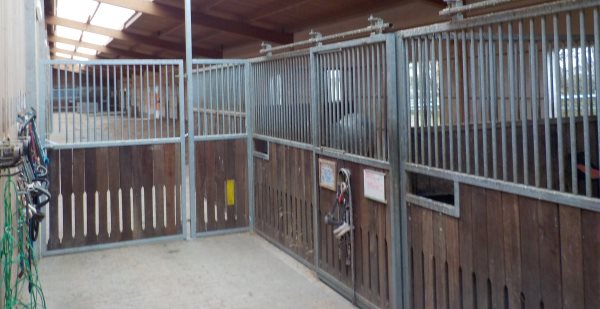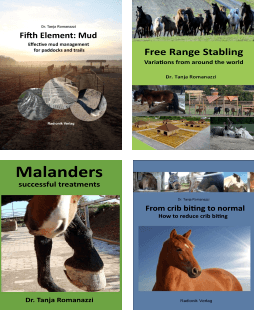Where to stable a sick free range horse?
If at all possible, the horse should remain within the free range area. Depending on the illness, familiar surroundings and exercise can be beneficial. But there will always be situations that necessitate temporarily stabling the horse inside a stall or an enclosed area, for example if even walking is clearly painful.
How to achieve this
Your main goal should be to make sure the sick horse isn’t alone and isolated from the other horses. Horses are herd animals and having no other horses around is very bad for them. Most horses will become very agitated and move around more than if you let them stay in the free range area. On top of that, the resulting psychological stress can also hinder recovery.
But if the free range stable covers a large area, it can be difficult to ensure that a sick horse has enough company. If, for example, you close off part of the rest area to create a sick area and the other horses spend most of their time far away at the hay racks, then the sick horse will be left on its own.
There are a number of ways to ensure your horse has company:
If the containers used for the hay feeds can be easily moved (nets, small racks), you could temporarily relocate the feeding points closer to the run-in shed.
Another possibility would be to enlarge the sick area and move a companion horse into the enclosure. This is of course only an option if you can find a horse that gets on well with your patient.
If your facilities are large enough, you may want to place the sick area somewhere close to other (conventionally stabled, or stabled in smaller free range enclosures) horses. It is not absolutely necessary, in my opinion, to provide the sick horse with company from its own herd, as long as there are any horses at all in the immediate vicinity.
At Gut Heinrichshof
We have used these methods in our own free range stabling facilities, with varying degrees of success. In three of the free range stables, we closed off separate areas around the run-in sheds, so that the horses stabled there are still close to their own herd or (additionally) the neighbouring herd (while their own gang was at the hay racks some distance away).
With regard to the other three groups, we have had to fall back on sick stalls located inside the riding hall. This worked very well if several of horses were ill. If just one horse was affected, it lacked company, particularly in the last few months (after we had the permanently occupied stalls taken down). For this reason (and because of an increased demand for mini free range stables), we have restructured and set up a small free range stable for 2 ponies between the sick stalls and the geldings’ rest area.
Example 1

On the left, you can see the two paddocks connected to the sick stalls adjoining on a larger paddock for the two ponies. (We will soon be enlarging this and adding a path along the strip currently covered with grass). Next to that is the large free range gelding stable.
And this is what it looks like from the inside:

The new mini free range stable was constructed to encroach slightly onto the larger group’s rest area. As the area is very large in relation to the number of horses, this was not a problem. The corridor thus created at the entrance for the free range group is an additional advantage.
If only one horse is sick, the two ponies will definitely be there to keep it company.
Example 2
This free range stable covers a very large area. To make sure the sick horse has as much company from other horses as possible, the sick area should be set up close to the hay racks.
The run-in shed should be as inexpensive as possible, while still being sufficiently sturdy. After extensive research on the internet, we decided on a panel tent. As a rule, I don’t really like panels because of the risk of injury (getting a leg hooked in a panel). In this case however, the panels have been covered with a windbreak net. I liked the stability and the greater width (4m) in relation to depth (3.6m). The price (1190,- + p&p) was, in my opinion, acceptable for this quality.
We used green compost as a bedding material inside the tent. Once this has firmed up, a layer of woodchips will be placed on top.
There is enough space for the horse to walk around comfortably inside the tent. We placed a water tub on one side and I also distributed two hay boxes and two hay toys around the tent.
As the mare in question requires an even surface to walk on (even when it freezes over), we had to install footing on the track. We had 30 perforated mats manufactured by the company HIT in storage. These had originally been purchased to improve the footing on the path across our hill. As the long spell of wet weather had prevented us from installing them there, we used them for our sick area instead.
These mats are excellent, by the way. They are very heavy (one mat weights 20 kg and measures 80 x 120 cm), which helps them remain very stable. The protuberant knobs also presumably make them ideal footings for inclined areas.
As the ground was frozen, we smoothed it out with a layer of compost, on top of which we placed first a layer of non-woven geotextiles and then the mats themselves. In this case (which required a footing that was as even as possible), we also covered them with finely chopped woodchips.
We also fenced off a small area next to the sick area for the water cart (hopefully it won’t freeze over any time soon) and a pallet with a hay bale on it.
And here’s a video of the entire thing (sorry for german explanations):

